MEMS Energy Harvesting Devices Market Size
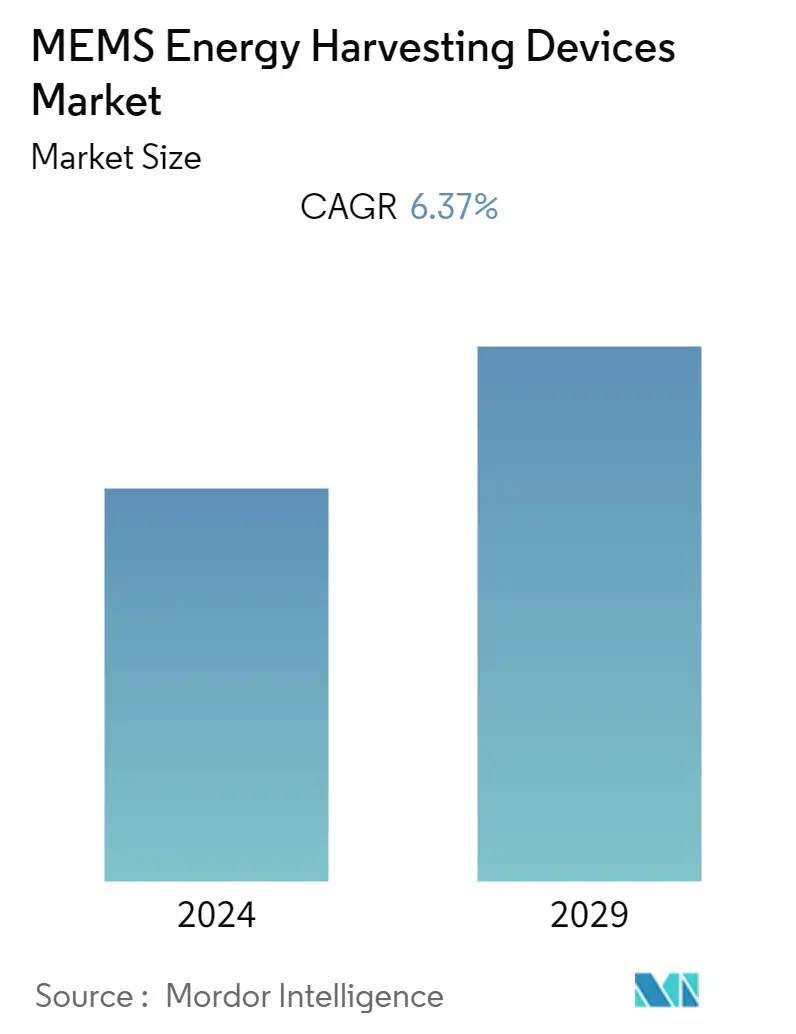
| Study Period | 2019 - 2029 |
| Base Year For Estimation | 2023 |
| CAGR | 6.37 % |
| Fastest Growing Market | Asia Pacific |
| Largest Market | Europe |
| Market Concentration | Medium |
Major Players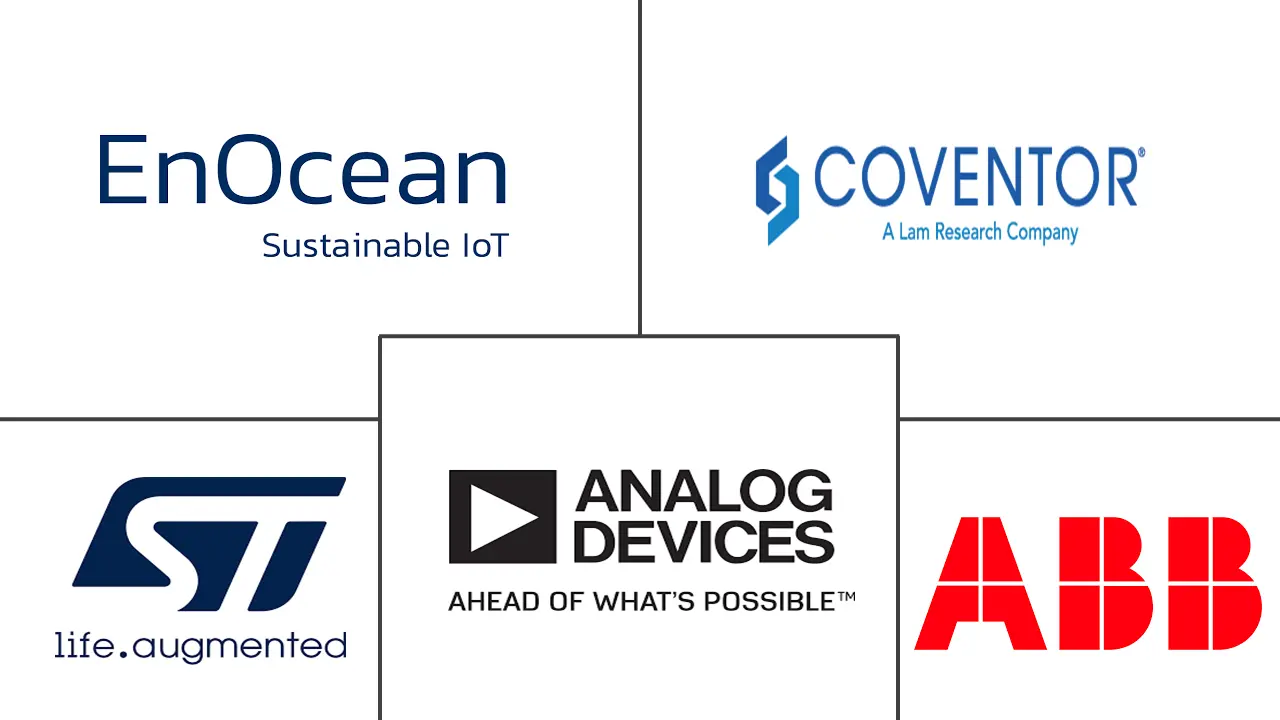
*Disclaimer: Major Players sorted in no particular order |
MEMS Energy Harvesting Devices Market Analysis
The MEMS energy harvesting devices market size was valued at USD 66.06 million the previous year and is expected to register a CAGR of 6.37%, reaching USD 92.62 million over the forecast period.
- Energy harvesting is used for decades for bicycle dynamos or solar panels. However, this technology is a revolution with staggering applications in building and industry automation, automotive vehicles, smart cities, and security systems. Notably, governments and favorable public initiatives are the major drivers for energy harvesting demand growth as public actors consider energy harvesting a crucial tool for meeting the increasing energy demand and saving energy. In addition, Big Data and IoT technologies led to autonomous energy-harvesting devices that require less maintenance and are easier to install than batteries.
- Moreover, the market for commercial building automation is also booming and is expected to experience significant growth with rising smart city initiatives. Energy harvesting wireless solutions find surging applications in building and home automation owing to their high cost-saving potential in installation and maintenance. Compared to copper wiring or batteries, energy-harvesting wireless technology is the ideal communication standard to interconnect thousands of building devices and find new monitoring and control applications.
- Microelectromechanical systems (MEMS) are considered the most suitable technology to realize IoT-sensing nodes. It facilitates the integrated fabrication of sensors/actuators, electronic circuits for information processing and radio frequency communication, antennas, and energy harvesters on a single chip or package. They may interact with biological, chemical, and thermal phenomena, including fluid interaction. At the same time, these devices usually interact with non-electromagnetic fields and forces, such as mechanical forces, piezoelectric and thermoelectric forces, among others. It promoted MEMS technology as an excellent tool for miniaturizing energy harvesters.
- In recent years, much development is made in energy harvesting from mechanical vibrations, thermal gradients, electromagnetic radiations, and solar radiations. This progress is made to provide alternative power sources to operate portable and personal gadgets instead of traditional batteries. As a result, the creation of ultra-low-power electronic devices became one of the main challenges likely to limit the adoption rate of MEMS-based harvesting devices.
- COVID-19 accelerated the pace towards a more patient-centric approach and increased the need for remote patient monitoring, including telehealth, point-of-care devices, and wearables. There is a growing demand for energy harvesters' wearables owing to their ability to track peoples' temperature and blood pressure. This trend created new opportunities in the wearables market, as well as for integrated MEMS sensors, such as pressure, inertial, microphones, thermopiles, etc.
MEMS Energy Harvesting Devices Market Trends
Building and Home Automation to Hold Major Share
- Building and home automation end-user application in the MEMS energy harvesting devices market refers to using MEMS-based energy harvesting devices. The devices power and enhance various automated systems and devices within residential and commercial buildings.
- The building and home automation end-user application in the MEMS energy harvesting devices market encompasses many applications. These include wireless sensor networks for monitoring parameters such as temperature, humidity, air quality, occupancy, and lighting levels. MEMS energy harvesting devices also power energy-efficient LED lighting systems, smart thermostats, zone-based HVAC controls, and security and surveillance systems. It also includes wireless security cameras and access control systems. Additionally, they enable the operation of smart home devices such as smart locks, appliances, voice-activated assistants, and entertainment systems.
- Further, the trend of building and home automation is driven by the increasing emphasis on convenience, as highlighted by Hippo Holdings' recent survey in the United States. It stated that convenience accounts for 46% of the utilization of smart home devices across all demographics. MEMS energy harvesting devices could be a potential solution to be adopted in building and home automation systems to meet this demand. By powering automated systems such as lighting controls, HVAC systems, security systems, and smart home devices, MEMS energy harvesting devices provide seamless and personalized experiences, enhancing occupants' comfort and convenience.
- Moreover, in North America, countries such as the United States and Canada are expected to witness rapid adoption growth of smart home technologies. Factors such as the presence of tech-savvy consumers, a strong emphasis on energy efficiency, and favorable government initiatives might be potential factors responsible for the market's growth.
- The building and home automation market is witnessing a growing trend towards integrating MEMS energy harvesting devices, owing to the rising emphasis on energy efficiency, sustainability, and the optimization of smart devices. Overall, the growth trajectory of building and home automation, coupled with advancements in MEMS energy harvesting technology, is expected to witness further expansion.
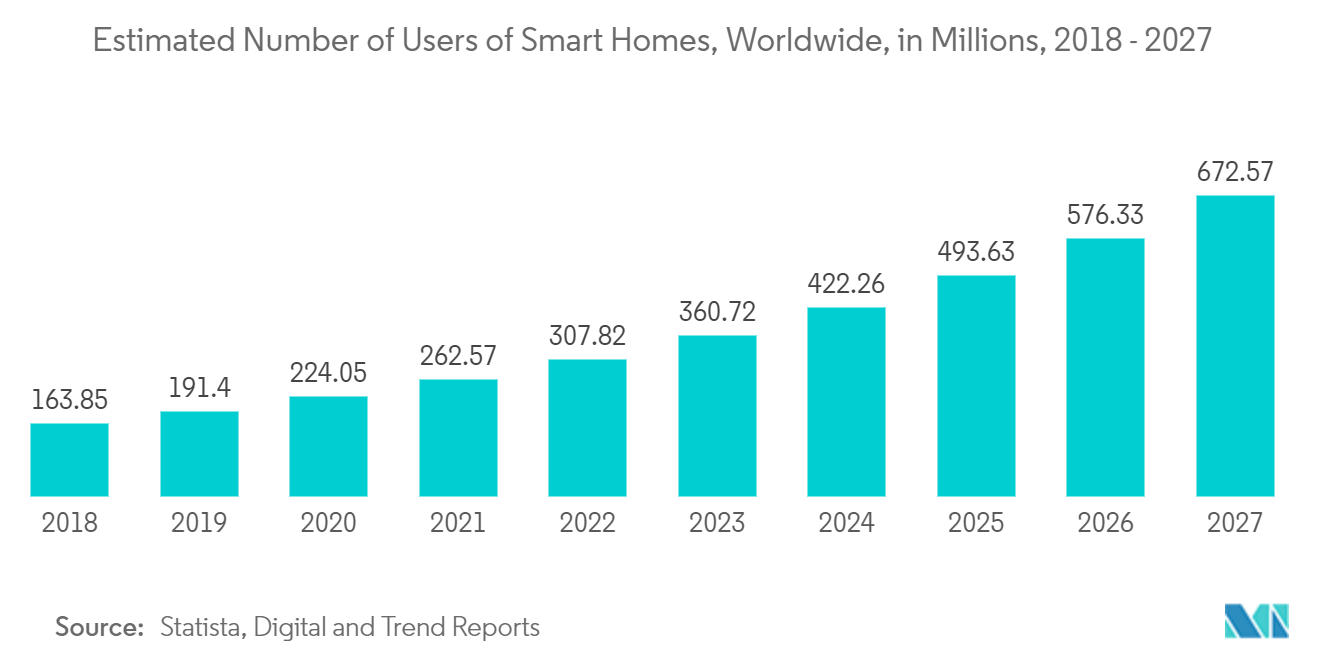
Asia-Pacific to Witness Fastest Growth
- Asian countries, particularly China, Japan, South Korea, and Taiwan, made significant strides in developing and manufacturing MEMS technologies. These countries include advanced research and development facilities, fostering innovation and pushing the boundaries of MEMS harvesting device capabilities.
- Asia is a manufacturing hub for a large consumer electronics market, with a high demand for portable devices such as smartphones, wearables, and IoT devices. MEMS harvesting devices provide an attractive solution for powering these devices by harnessing ambient energy, reducing the dependence on traditional batteries.
- Also, MEMS sensors became one of the most important components in automobiles due to their ability to reduce emissions and fuel consumption, increase stability and safety, and improve the comfort and convenience of passengers. The cost-effective capability of MEMS sensors led to the development of several sensors for automotive applications. It includes accelerometers, gyroscopes, radiation and temperature sensors, and pressure and vibration sensors.
- These devices play a critical role in improving the safety of vehicles. This factor acts as the catalyst for the growth of the market. In September 2022, SiTime Corporation introduced a new automotive oscillator family based on its advanced MEMS technology. The new differential oscillators are 10x more resilient and ensure reliable operation of ADAS across extreme road conditions and temperatures.
- Moreover, governments across Asia implemented policies and initiatives to promote clean energy technologies and reduce reliance on fossil fuels. For instance, in January 2023, the first India-Japan environment week took place during the event. India set an ambitious target of achieving net zero by 2070. Japan initiated a goal of becoming net zero by 2050. These measures often include financial incentives, research grants, and collaborations with industry players, creating a conducive environment. These initiatives by the government for clean energy will increase the growth of the MEMS harvesting device market.
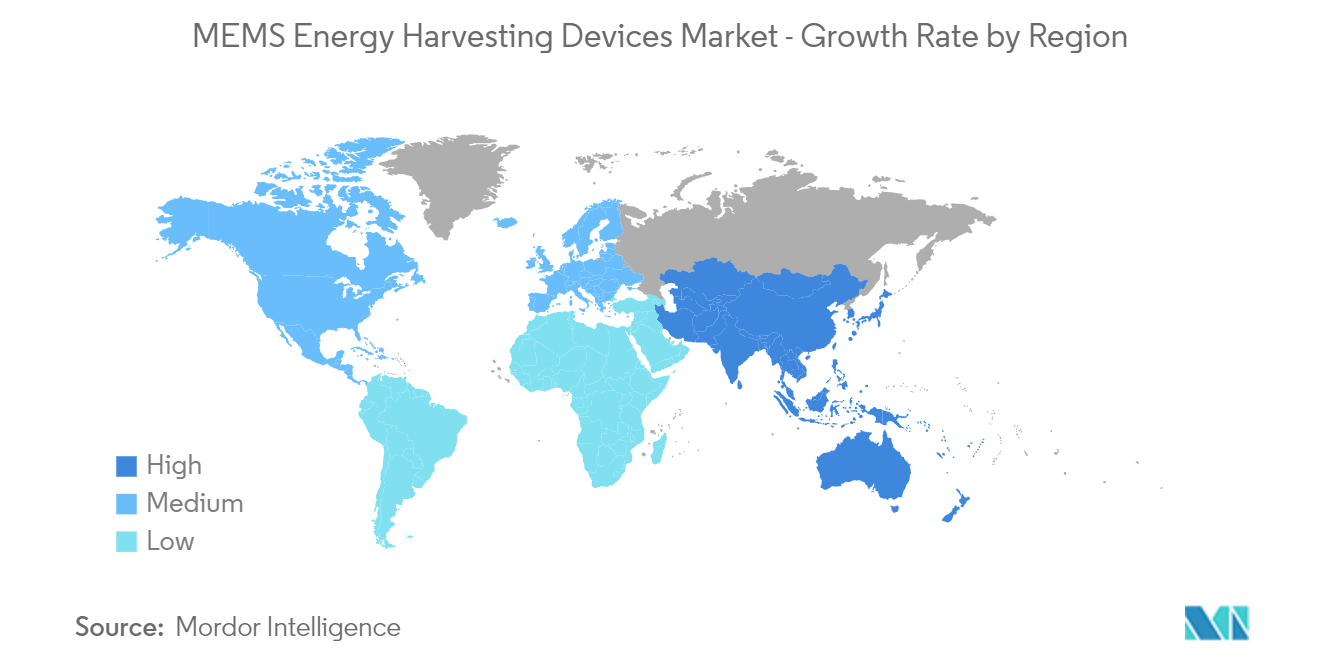
MEMS Energy Harvesting Devices Industry Overview
The MEMS energy harvesting device market comprises many large-scale vendors capable of backward and forward integration and commands significant revenue generation capabilities. The market is relatively consolidated, and vendors increasingly spend on R&D to gain technological capabilities and a competitive edge over other enterprises. The vendors in the market are competing on technology and quality rather than on price. This market is characterized by moderate-to-high product differentiation, growing levels of product penetration, and high levels of competition. Generally, the products offered include customer customizations. Some of the major market players are EnOcean Gmbh, STMicroelectronics NV, Coventor Inc. (Lam Research Corporation), Analog Devices Inc., and ABB Ltd.
- May 2023- STMicroelectronics introduced the first MEMS water/liquid-proof absolute pressure sensor with a declared 10-year longevity program for the industrial market.
- April 2023- EnOcean's innovative energy-harvesting wireless technology significantly reduces carbon emissions. As of the end of April 2023, with over 19,000,000 devices sold, the company could save a remarkable 1,403,302 tons of CO2. It is primarily because of its self-powered solutions that eliminate the need for batteries or cables and helps make buildings more energy efficient.
MEMS Energy Harvesting Devices Market Leaders
-
EnOcean Gmbh
-
STMicroelectronics NV
-
Coventor Inc. (Lam Research Corporation)
-
Analog Devices Inc
-
ABB Ltd
*Disclaimer: Major Players sorted in no particular order
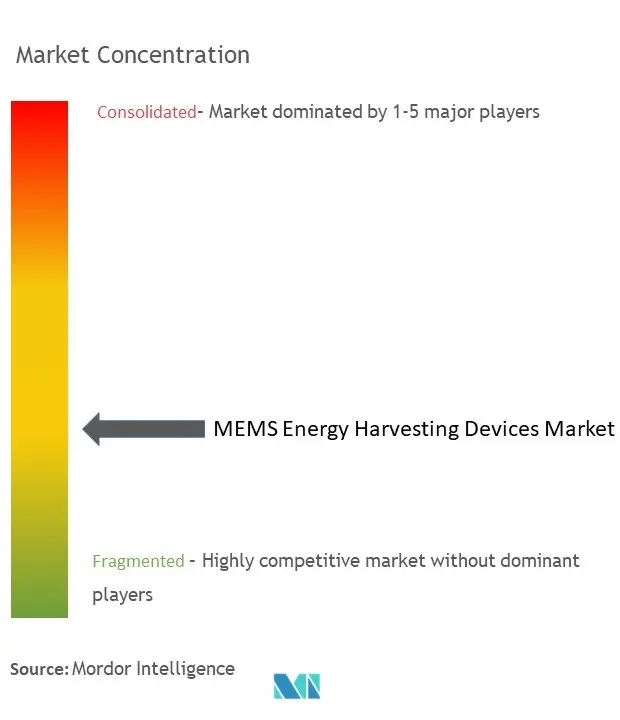
MEMS Energy Harvesting Devices Market News
- February 2023: Asahi Kasei Microdevices (AKM) launched a new DC-DC step-up converter for efficient energy harvesting applications. It can boost low voltages, offering remote and battery-free operation solutions and low-maintenance asset monitoring and IoT applications.
- January 2023: WePower Technologies, a kinetic energy harvesting startup providing scalable and sustainable power solutions for wireless IoT sensors, transmitters, and related devices, unveiled their Gemns Energy Harvesting Generator (EHG) product line. The Gemns product line includes three different products. Each uses permanent and oscillating magnets to harvest kinetic energy through electromagnetic induction: the Gemns G100 Integrated RF Switch, the Gemns G200 EHG, and the Gemns G300 EHG.
MEMS Energy Harvesting Devices Market Report - Table of Contents
1. INTRODUCTION
- 1.1 Study Assumptions and Market Definition
- 1.2 Scope of the Study
2. RESEARCH METHODOLOGY
3. EXECUTIVE SUMMARY
4. MARKET INSIGHTS
- 4.1 Market Overview
-
4.2 Industry Attractiveness - Porter's Five Forces Analysis
- 4.2.1 Bargaining Power of Suppliers
- 4.2.2 Bargaining Power of Buyers
- 4.2.3 Threat of New Entrants
- 4.2.4 Threat of Substitute Products
- 4.2.5 Intensity of Competitive Rivalry
- 4.3 Industry Value Chain Analysis
- 4.4 Impact of COVID-19 on the Market
5. MARKET DYNAMICS
-
5.1 Market Drivers
- 5.1.1 Growth of Smart Cities
- 5.1.2 Commercial Applications are Slowly Getting into the Market for Industrial Applications and Home Automation Appliances
-
5.2 Market Restraints
- 5.2.1 Ultra Low Power Electronics
- 5.2.2 Wireless Data Transmissions Rates and Standards
6. MARKET SEGMENTATION
-
6.1 By Technology
- 6.1.1 Vibration Energy Harvesting
- 6.1.2 Thermal Energy Harvesting
- 6.1.3 RF Energy Harvesting
- 6.1.4 Other Types of Energy Harvesting
-
6.2 By End-user Applications
- 6.2.1 Automotive
- 6.2.2 Industrial
- 6.2.3 Military and Aerospace
- 6.2.4 Building and Home Automation
- 6.2.5 Consumer Electronics
- 6.2.6 Other End-user Applications
-
6.3 By Geography
- 6.3.1 North America
- 6.3.2 Europe
- 6.3.3 Asia-Pacific
- 6.3.4 Rest of the World
7. COMPETITIVE LANDSCAPE
-
7.1 Company Profiles
- 7.1.1 EnOcean Gmbh
- 7.1.2 STMicroelectronics NV
- 7.1.3 Coventor Inc. (Lam Research Corporation)
- 7.1.4 Analog Devices Inc
- 7.1.5 ABB Ltd
- 7.1.6 Cymbet Corp
- 7.1.7 Micropelt (EH4 GmbH)
- *List Not Exhaustive
8. INVESTMENT ANALYSIS
9. MARKET OPPORTUNITIES AND FUTURE TRENDS
** Subject To AvailablityMEMS Energy Harvesting Devices Industry Segmentation
MEMS energy harvesting devices capture and accumulate byproduct energy as it becomes available and then store it for some time. These devices then supply it in a form that can be used later, such as operating a microprocessor within its limits. It supports energy harvesting systems that can also be used in low-voltage and low-power applications, such as portable or mobile devices, automotive, medical, industrial machine monitoring and process control, home automation, and defense.
The MEMS energy harvesting devices market is segmented by technology (vibration energy harvesting, thermal energy harvesting, RF energy harvesting, and other types of energy harvesting), end-user applications (automotive, industrial, military and aerospace, building and home automation, consumer electronics, and other end-user applications), and geography (North America, Europe, Asia-Pacific, and rest of the world). The market sizes and forecasts are in value (USD) for all the segments.
| By Technology | Vibration Energy Harvesting |
| Thermal Energy Harvesting | |
| RF Energy Harvesting | |
| Other Types of Energy Harvesting | |
| By End-user Applications | Automotive |
| Industrial | |
| Military and Aerospace | |
| Building and Home Automation | |
| Consumer Electronics | |
| Other End-user Applications | |
| By Geography | North America |
| Europe | |
| Asia-Pacific | |
| Rest of the World |
MEMS Energy Harvesting Devices Market Research FAQs
What is the current MEMS Energy Harvesting Devices Market size?
The MEMS Energy Harvesting Devices Market is projected to register a CAGR of 6.37% during the forecast period (2024-2029)
Who are the key players in MEMS Energy Harvesting Devices Market?
EnOcean Gmbh, STMicroelectronics NV, Coventor Inc. (Lam Research Corporation), Analog Devices Inc and ABB Ltd are the major companies operating in the MEMS Energy Harvesting Devices Market.
Which is the fastest growing region in MEMS Energy Harvesting Devices Market?
Asia Pacific is estimated to grow at the highest CAGR over the forecast period (2024-2029).
Which region has the biggest share in MEMS Energy Harvesting Devices Market?
In 2024, the Europe accounts for the largest market share in MEMS Energy Harvesting Devices Market.
What years does this MEMS Energy Harvesting Devices Market cover?
The report covers the MEMS Energy Harvesting Devices Market historical market size for years: 2019, 2020, 2021, 2022 and 2023. The report also forecasts the MEMS Energy Harvesting Devices Market size for years: 2024, 2025, 2026, 2027, 2028 and 2029.
MEMS Energy Harvesting Device Industry Report
Statistics for the 2024 MEMS Energy Harvesting Device market share, size and revenue growth rate, created by Mordor Intelligence™ Industry Reports. MEMS Energy Harvesting Device analysis includes a market forecast outlook 2029 and historical overview. Get a sample of this industry analysis as a free report PDF download.



